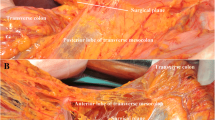Abstract
Background
Bursectomy, a procedure dissecting the peritoneal lining covering the pancreas and the anterior plane of the transverse mesocolon, has been commonly performed with radical gastrectomy for gastric cancer patients. Although possibly improving the prognosis of gastric cancers, adverse events related to bursectomy should be evaluated in prospective studies.
Methods
This prospective randomized controlled trial was conducted by experienced surgeons in 11 Japanese institutions. Patients with T2 or T3 gastric adenocarcinoma were intraoperatively randomized to radical gastrectomy plus D2 lymphadenectomy either with or without bursectomy. Postoperative morbidity and mortality were compared between the two groups.
Results
A total of 210 patients were assigned to the bursectomy group (104 patients) and the nonbursectomy group (106 patients) between July 2002 and January 2007. Background characteristics were well balanced. Intraoperative blood loss was greater in the bursectomy group than in the nonbursectomy group (median 475 vs. 350 ml, p = 0.047), whereas other surgical factors did not vary significantly. The overall morbidity rate was 14.3% (30 patients), the same for the two groups. Likewise, the incidence of major postoperative complications, including pancreatic fistula, anastomotic leakage, abdominal abscess, bowel obstruction, hemorrhage, and pneumonia, were not significantly different between the two groups. The medians of the amylase level of the drainage fluid on postoperative day 1 were similar for the two groups (median 282 vs. 314 IU/L, p = 0.543). The hospital mortality rate was 0.95%: one patient per group.
Conclusions
Experienced surgeons could safely perform a D2 gastrectomy with an additional bursectomy without increased major surgical complications.

Similar content being viewed by others
References
Kelley JR, Duggan JM (2003) Gastric cancer epidemiology and risk factors. J Clin Epidemiol 56:1–9
Jinnai D (1967) Theory and practice of the extended radical operation for gastric cancer. Rinsho Geka 22:19–24 (in Japanese)
Maruyama K, Okabayashi K, Kinoshita T (1987) Progress in gastric cancer surgery in Japan and its limits of radicality. World J Surg 11:418–425
Groves EWH (1910) On the radical operation for cancer of the pylorus. BMJ 12:366–370
Oglivie WH (1939) Cancer of the stomach. Surg Gynecol Obstet 68:295–305
Japanese Gastric Cancer Association (2004) Gastric cancer treatment guidelines. Kanehara, Tokyo (in Japanese)
Hagiwara A, Sawai K, Sakakura C et al (1998) Complete omentectomy and extensive lymphadenectomy with gastrectomy improves the survival of gastric cancer patients with metastases in the adjacent peritoneum. Hepatogastroenterology 45:1922–1929
Bonenkamp JJ, Hermans J, Sasako M et al (1999) Extended lymph-node dissection for gastric cancer. N Engl J Med 340:908–914
Cuschieri A, Weeden S, Fielding J et al (1999) Patient survival after D1 and D2 resections for gastric cancer: long-term results of the MRC randomized surgical trial. Br J Cancer 79:1522–1530
Japanese Gastric Cancer Association (1998) Japanese classification of gastric carcinoma: 2nd English edition. Gastric Cancer 1:10–24
Sasako M, Yamaguchi T, Kinoshita T et al (2007) Randomized phase III trial comparing S-1 monotherapy versus surgery alone for stage II/III gastric cancer patients (pts) after curative D2 gastrectomy (ACTS-GC study) (abstract). In: Proceedings of the American Society of Clinical Oncology (gastrointestinal cancers symposium) (abstract 8)
Sakuramoto S, Sasako M, Yamaguchi T et al (2007) Adjuvant chemotherapy for gastric cancer with S-1, an oral fluoropyrimidine. N Engl J Med 357:1810–1820
Wu CW, Hsiung CA, Lo SS et al (2006) Nodal dissection for patients with gastric cancer: a randomised controlled trial. Lancet Oncol 7:309–315
Sasako M, Sano T, Yamamoto S et al (2008) D2 lymphadenectomy alone or with para-aortic nodal dissection for gastric cancer. N Engl J Med 359:453–462
Herbella FA, Tineli AC, Wilson JL Jr et al (2008) Gastrectomy and lymphadenectomy for gastric cancer: is the pancreas safe? J Gastrointest Surg 12:1912–1914
Hagiwara A, Takahashi T, Sawai K et al (1993) Milky spots as the implantation site for malignant cells in peritoneal dissemination in mice. Cancer Res 53:687–692
Acknowledgments
We thank Professor Kunio Okajima for helpful advice and Dr. Tomoyuki Sugimoto for statistical analysis of this study.
Conflict of interest
The authors declare no conflicts of interest.
Author information
Authors and Affiliations
Corresponding author
Rights and permissions
About this article
Cite this article
Imamura, H., Kurokawa, Y., Kawada, J. et al. Influence of Bursectomy on Operative Morbidity and Mortality After Radical Gastrectomy for Gastric Cancer: Results of a Randomized Controlled Trial. World J Surg 35, 625–630 (2011). https://doi.org/10.1007/s00268-010-0914-5
Published:
Issue Date:
DOI: https://doi.org/10.1007/s00268-010-0914-5




